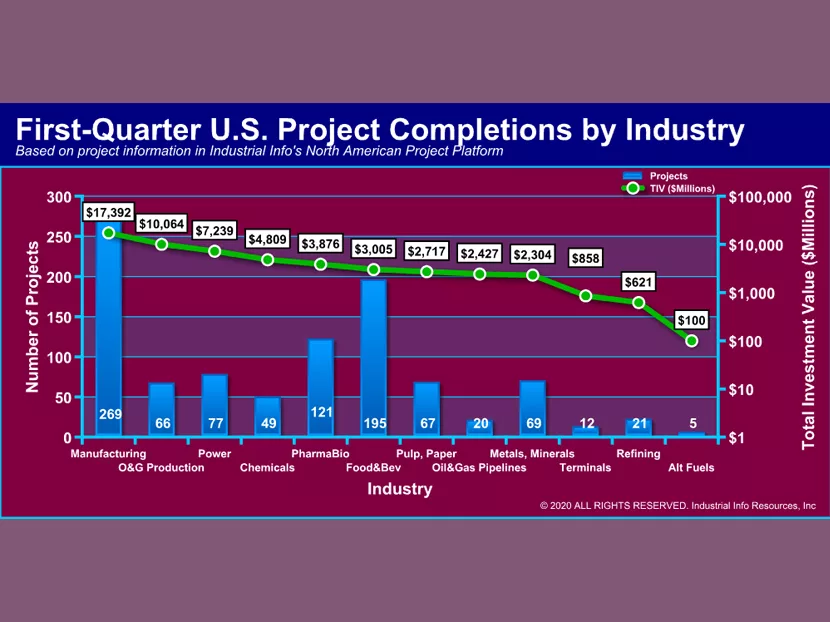Amid continued uncertainty over the long-term impact of the COVID-19 coronavirus, oil and gas prices, and the economy in general, Industrial Info Resources has tracked more than $55 billion worth of U.S. capital projects requiring pipe, valves and fittings (PVF) that were planned for completion in the first quarter of 2020.
Among the 12 industries tracked by Industrial Info, industrial manufacturing led in planned first-quarter completions (see Figure 1), with more than $17 billion worth of projects, followed by oil and gas production ($10 billion) and electric power ($7.6 billion).
Industrial Manufacturing
The industrial manufacturing industry covers a wide range of sectors such as distribution and warehousing, semiconductors and computers, and automotive projects.
Despite the economic turmoil that emerged this year, companies still need data centers that can be accessed by partners around the world. While millions of businesses have digitized their processes, millions more continue to rely on pen-and-paper calculations or spreadsheets.
Rising concerns over cybersecurity and data resilience in the aftermath of disasters or disruptions also are pushing companies to entrust more of their data in third-party offsite locations.
The burgeoning growth of data centers is shown in project activity tracked by Industrial Info. In the two years between January 2014 and December 2015, only eight data center projects valued at about $1.75 billion were completed across North America. For the 2016-2017 period, those numbers jumped to 18 completed projects, valued at $3.79 billion.
And in the most recent two-year period, 2018-2019, 54 data center projects were completed across North America, with a collective value of $7.83 billion.
Oil and Gas Production
Plummeting oil prices rocked the industry during the first quarter, prompting oil and gas producers to slash planned capital expenditures. These cuts stemmed from the double whammy of a Saudi Arabia-led crude oil price war, which hammered oil prices, and the growing realization of the scope and scale of the COVID-19 coronavirus.
The International Energy Agency (IEA) earlier this year projected global demand for crude oil would fall by about 2.5 million barrels per day for the first quarter. Most of that decline could be traced to the slowdown of the Chinese economy. But the IEA’s projection was made before health officials identified COVID-19 as a global pandemic, which made matters worse.
Still, the industry saw a significant number of project completions during the first three months of the year, including liquefied natural gas processing facilities worth a combined $5.5 billion and natural gas processing projects valued at $3.7 billion.
Power
The power industry includes electric generation and transmission as well as distribution projects. Attendees at Industrial Info’s 2020 Industrial Market Outlook earlier this year were told there is a lower level of capital construction activity expected this year than in years past because electric load growth is negligible for most regions. This is due in large part to utility energy-efficiency programs holding down customer demand growth.
“What new generation that is getting built is renewable, for the most part, because federal and state policies encourage it and because costs continue to decline,” Britt Burt, Industrial Info’s vice president of global research for the power industry, said during the event.
Generation asset owners in North America are expected to retire about 8,000 megawatts (MW) of coal-fired generation in 2020, about half of what they retired in 2019, Burt said. He expects retirements to fall to less than 2,000 MW next year before shooting up to about 9,300 MW in 2022.
Low-cost natural gas, increasingly competitive renewable generation such as wind and solar, and federal and state policies have placed coal-fired generation in an economically challenging position. In the U.S. Energy Information Administration’s (EIA) February Short-Term Energy Outlook, the agency predicted coal’s share of the electric fuel market would fall to 21 percent this year and next, down from 24 percent in 2019.
In 2019, coal use by U.S. electric generators fell about 15 percent to approximately 538 million short tons, according to the EIA. A further decline is expected in 2020 as asset owners continue with plans to close generators.
Coal use by power generators has fallen nearly 50 percent from its recent highs. As recently as 2003 to 2008, U.S. generators burned more than 1 billion short tons per year, the EIA notes.
More than half of the U.S. coal-fired power projects set for kickoff in the second half of this year involve ash pond closures and plant dismantlements and demolitions.
Less well-publicized has been the retirement of gas-fueled power plants across North America. Retirements peaked in 2018 at about 9,400 MW before falling to about 2,450 MW in 2019. This year, about 6,300 MW of gas-fueled generation is expected to be closed. Still, the EIA projects that gas will generate about 38 percent of the nation’s electricity in 2020, up from 37 percent in 2019.
Renewables’ share of the power fuel mix will rise to 20 percent in 2020 and 21 percent in 2021, up from 17 percent in 2019, the EIA notes. Nuclear power is expected to continue generating about 20 percent of the country’s electricity.
Market Regions
By project value, the highest amount of first-quarter completions was in the U.S. Southwest region, which includes Texas, Louisiana, Oklahoma and Arkansas.
Not surprisingly, oil and gas production claimed the lion’s share of planned first-quarter completions, with $9.4 billion worth of projects. This was followed by $4 billion worth of chemical projects.
Industrial Info will continue to closely monitor the development of projects in the United States and the rest of the world as the year progresses.




